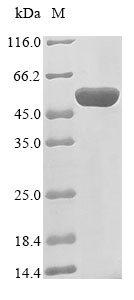Just like other recombinant proteins, the production of this recombinant E.coli ampC protein began with appropriate cDNA and PCR methods, and then the ampC expression plasmids were built. Following sequence determination of the constructs, plasmids were transformed into E.coli for the expression of the recombinant E.coli ampC protein. N-terminal 6xHis-SUMO tag was used in the process. And we finally get the protein of interest with purity of 85%+.
ampC (also called ampA) is a gene providing an instruction of making a protein named beta-lactamase (also known as cephalosporinase) in Escherichia coli (E.coli). This protein belongs to Class-C beta-lactamase family, which are enzymes produced by bacteria, E.coli and Klebsiella. The protein encoded by ampC hydrolyzes the beta-lactam bond in susceptible beta-lactam antibiotics and takes part in antibiotic catabolic process and the process of response to antibiotic.






